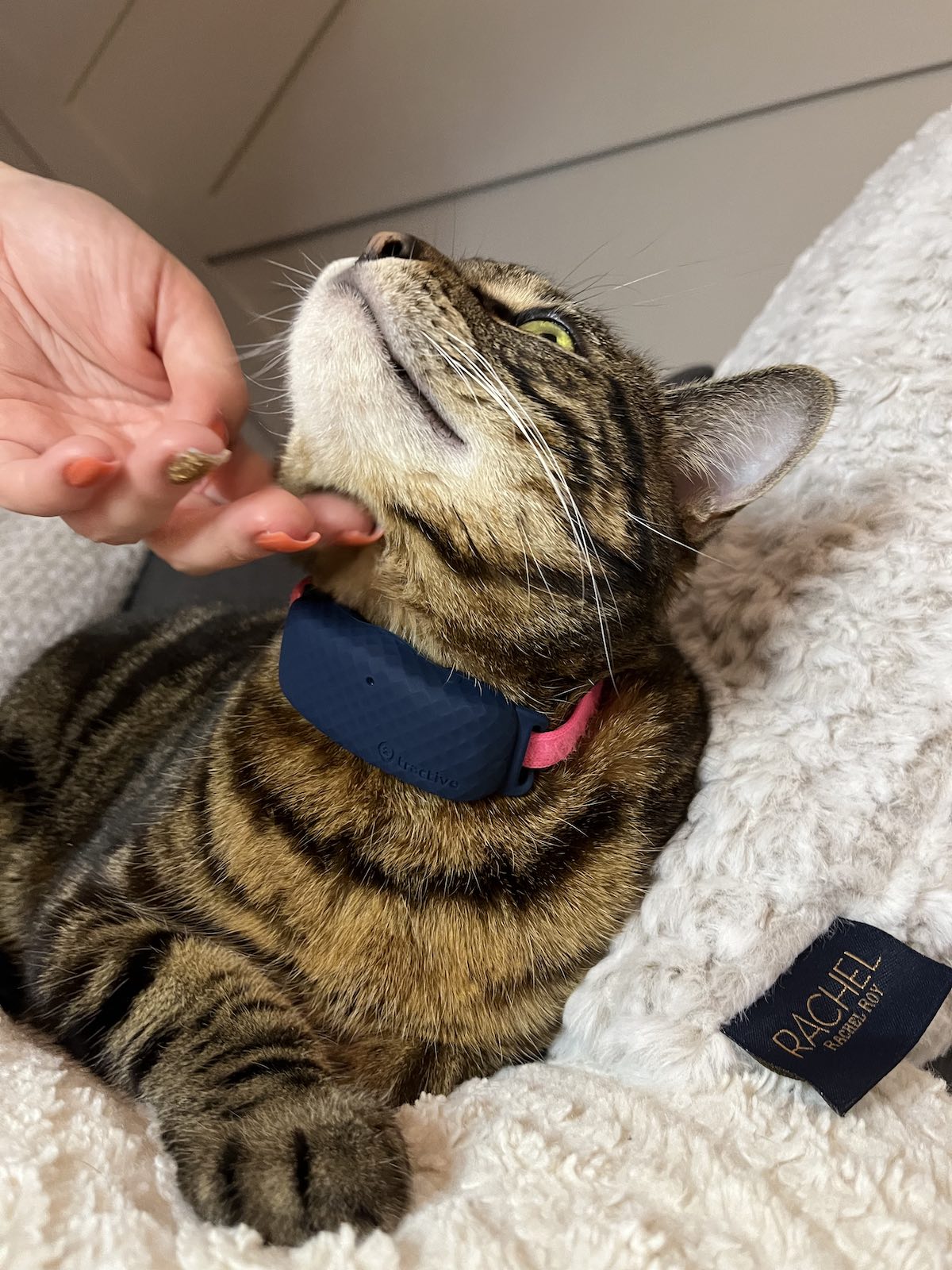Quick Answer
- Shock collars can be safe for cats when used correctly but may cause harm if shock intensity is excessive.
- Shock collars are generally considered inhumane for controlling cat behavior and considered a last resort when other training methods fail.
- Best for short-term use in conjunction with positive behavior and should be phased out once desired behavior is achieved.
- Banned in several countries due to concerns about cruelty and ineffectiveness.
- Alternatives include positive reinforcement, clicker training, target training, and professional cat trainers.
Everybody loves an adorable cat, but not everyone can control their cat to stay in a safe space or to be well-behaved towards people and other pets. Cats can get into trouble due to their curious and aggressive nature. In such cases, some cat parents turn to a cat shock collar and shock collar training as potential solutions.
What is a Cat Shock Collar?
A cat shock collar, also known as a remote training collar or electronic collar, is a valuable training device designed to discourage aggressive behavior and prevent cats from accessing restricted areas. These devices resemble regular pet collars but include a small attached box.
There is a wide variety of shock collars for cats on the market, available in various designs and styles.
I personally used a shock collar to train my cat, specifically to keep her within our yard. I opted for a collar equipped with adjustable correction methods, enabling me to fine-tune the settings and apply the mildest correction as needed.
How Does Cat Shock Collar Function?
This device administers electrical stimulation or vibration of varying intensities and durations to the cat’s neck as a form of correction. A shock collar typically features two prongs on one side that penetrate the cat’s fur, making contact with its skin. The intensity and duration of the shock are pre-programmed or adjustable.
Cat Shock collars are designed to help your cat associate undesirable behavior with an unpleasant sensation, discouraging them from repeating the behavior. The shock is activated when the cat crosses an invisible electronic fence or when prompted by the owner using a remote control.
Owners can administer a shock at the push of a button, primarily used to deter unwanted behaviors like aggression towards other people or animals. Most shock collars are equipped with a remote control.
Cat invisible fences consist of electronically wired boundaries buried underground on your property’s perimeter. They are commonly used to confine your cat within your yard, preventing them from wandering, encountering potential road hazards, or getting lost. These fences transmit signals to the shock collar when the cat approaches the boundary.
Shock collars allow you to signal your cat remotely by delivering a gentle shock using the provided remote control. Some cat owners find shock collars effective for grabbing their cat’s attention, even from a distance. These collars can also be effective when you’re not physically present, as long as you’ve established invisible electronic boundaries.
It’s important to note that there are shock collars specifically designed for cats, and a variety of options are available, including water-resistant models. Using a shock collar tailored for cats is strongly recommended.
Training your cat with these specialized collars can be challenging and may require time and effort. I’ve personally used a cat training collar and, with patience and consistency, have achieved positive results.
Do Cats Respond to Shock Collars?
Are cat shock collars cruel? The use of a shock collar is a subject of controversy, with many cat lovers viewing it as a form of torture and animal abuse. Despite the debate surrounding shock collars, there are reasons, as mentioned earlier, why some individuals may opt to utilize them.
It’s essential to understand that relying solely on shock collars for cat training is insufficient. Positive reinforcement should always accompany the use of these collars, rewarding your cat for good behavior.

Cats have diverse reactions to shock collars. While some cats respond positively, achieving the desired results, others may exhibit anxiety, confusion, stress, and fear. In some cases, the use of shock collars can escalate aggression rather than curb it.
Additionally, shock collars may render your cats inactive and overly cautious in their actions, particularly when employed in isolation without other training methods.
In my experience, after using a shock collar on my cat and supplementing it with positive reinforcement, I successfully taught her to respect my established boundaries. While shock collars can be effective tools, they should be used with caution and in conjunction with other training techniques, considering your cat’s individual temperament and response.
Can Cats Safely Use Shock Collars?
Cat shock collars are considered safe when used correctly; however, excessive shock intensity can potentially harm your cat. This approach of administering shocks to control cat behavior is widely regarded as inhumane, causing undue harm and discomfort.
It’s crucial to note that shock collars are not suitable for cats with cardiovascular diseases or nervous system issues. They are best suited for short-term use, should be discontinued once the desired behavior is achieved, and positive reinforcement should be incorporated into training.
Many veterinarians consider shock collars cruel and ineffective for behavior modification. While they may not be illegal in some American states, several countries, including England, Scotland, Wales, Germany, Portugal, Denmark, and Australia, have banned their use.
Typically, the use of shock collars is considered a last resort, employed when owners believe they’ve exhausted all other training methods without success.
Final Words
Choosing a safe cat collar is crucial to keep your furry friend out of harm’s way. Cat shock collars, even with adjustable settings, don’t always guarantee the desired behavior. Most shock collars can deliver up to 6000 volts of shock, which can seriously hurt your cat.
If you’re concerned about using shock collars on your cat, there are gentler and more practical training methods and precautions you can explore for your cat’s well-being. For example, some alternatives to shock collars include positive reinforcement training, clicker training, target training, as well as professional cat trainers.
If your cat is more of an explorer than a troublemaker and loves to venture beyond their turf, the Tractive GPS Cat Tracker is a great alternative to an invisible fence that works in conjunction with a shock collar. It’s an ideal choice for those cats who aren’t into mischief but can’t resist the call of the great outdoors.
While many people might think of Tractive as a cat GPS collar, it’s actually a versatile solution and something I highly recommend. Here’s the cool part: it boasts a great feature called the “Virtual Fence,” tailor-made to help you keep your furball within safe boundaries. If your cat decides to step out of this designated zone, you’ll receive a prompt notification right on your smartphone through the Tractive app. So, no more worries about your little explorer’s whereabouts and it’s a fantastic alternative to cat shock collars.









Clair,
Need some “CAT” advice. We own an indoor/outdoor cat. A very good cat, most of the time. We have two big dogs too which the cat gets along with well, maybe too well. The problem is our cat is adventurous, not afraid of anything, and has probably has used up its nine lives. It has lived in the same house/area for 10+ years and is generally regarded as one of the neighborhood cat. Our cat, Tiger, stays mostly in the house or yard, but has been known to wander within the neighborhood. The cat is playful and mostly gentle. The cat loves to sit semi-hidden in the front yard and watch life pass by. People walk by and he’ll venture to see them, those with dogs get the same attention and people laugh at the cats fearlessness around dogs. Okay, here’s the kicker – small dogs, yorkie size, look like play toys to him and has been known to play savannah cat with the small dogs, like a lion on a Wildebeest. I know our cat is playing, but understandingly, the dog owners get extremely upset and have threatened us to do something or they will call authorities. Bad thing, the last attack was the next door neighbor and has caused quiet a stir. I can’t keep the cat locked inside as it would be unfair to the cat. Thinking of trying to schedule the cats outside time, but still unlikely to stop the behavior. Seriously was considering a shock collar and giving a control to the neighbor when they go out to walk their dog…. need some sound advice to save our cat and our relationship with the neighbor.
Cats are way harder to train even with the use of shock collars and invisible fences. Have you considered a big outside playpen for your cat?